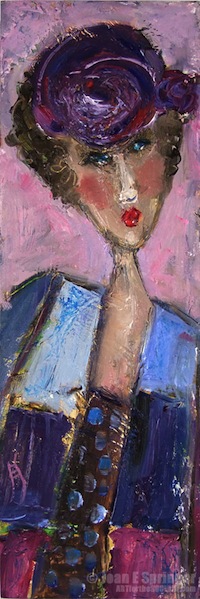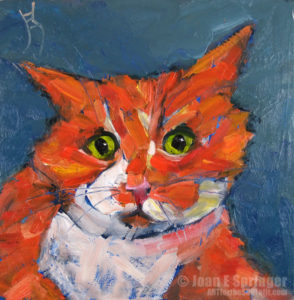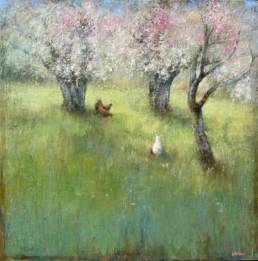
Years ago, I made the move from Southern California to the Rocky Mountains in hopes of a healthier lifestyle.
However, I did not know that the air pollution in my art studio and home may be more of a health concern than the any city’s air pollution outside!
According to a number of national organizations, including the American Lung Association, the Consumer Product Safety Commission, and the Environmental Protection Agency, studies have shown that indoor pollutant levels may, in fact, be two to five or more times higher than outdoor levels – and an artist’s studio is even worse
A while back, I visited the blog ART for the SOUL of it owned by the artist, Joanie Springer. I was impressed with her commitment to creating an Earth-friendly and healthy art studio I asked her to share her tips with us. Thank you, Joanie!
Creating an Earth-Friendly & Healthy Art Studio
Guest artist/author: Joanie Springer

As an artist, I have set a goal. Actually I have many, but one very high up on my list is to have a Solvent-Free, Toxic-Free, and Cruelty-Free studio and this short article is my approach to this goal.
The ultimate peace, for me, is to never have to worry about my own health, or those in my environment, including my cats, as well as the knowledge that I am not bringing harm to any other creature sharing this planet.
The Solvent-Free portion is easily accomplished by using water-mixable, often referred to as water miscible, oil paints. I love them!
Having not used traditional oils, I did not have the sometimes awkward adjustment as others. But, I could not use oils if there were no water-mixable alternatives as solvents set me wheezing, so I’m thrilled to have discovered them.
A few years ago when I set out on my artist’s journey, I started with ink and watercolor, took a turn to acrylics, then to open acrylics, and ah, found oils! There was no going back. The most difficult hurdle was finding a medium that worked for me, and my style of painting. I have only tried a few water-mixable mediums and none have dazzled me, so what I am excited to be using is walnut alkyd medium (M Graham), and at times, wax (Dorland).
Toxic-Free Pigments:
Because I prefer not to use gloves when I paint, tend to be quite messy, and at times can’t resist sticking my fingers in my paintings for a swipe here, a fingerprint there, I choose to use Toxic-Free pigments. It’s a journey.
I have found excellent alternatives to toxic pigments:
- Cadmium Red substitute is Grumbacher Red/Grumbacher Max
- Cadmium Yellow substitute is Primary Yellow Light/Cobra though there are a few others I’m trying out as well.
- Non-toxic Cerulean and Cobalt, both by Artisan.

I was shocked to see that even some Sap Greens and Titanium Whites have warnings. It’s been eye-opening to pay attention to these 65/CL warnings. Watch for those. DickBlick.com lists them clearly to the right of each item. I also love their large swatch view and pigment information.
Cruelty-free:
When I first started painting in watercolor I bought some lovely kolinsky brushes . As I used them I couldn’t help but wonder how they were made….. I inquired, and most people didn’t know.
But I did stumble upon a video that sobered me (for they are made from the tail of a weasel). So, thankfully there are so many wonderful brushes in the synthetic fibers that this choice was an easy one.
- The DaVinci Top Acryl is just the perfect stiffness for me and a really fantastic brush. I prefer a rigid surface, either wood, masonite, or canvas panels over the stretched canvas so a good stiff, but springy, the brush is essential.
Toxic-Free Clean-Up:
I use Master’s Brush Cleaner and Conditioner for cleaning up, but of course, wipe each brush clean and swish it in the water while I’m painting, but when it’s time to clean brushes, I use Masters. That’s it. Very easy. I really like their soap too for cleaning up my hands and supplies, and I’ve discovered that it even works fine on my brushes, too.
I‘ve written more in-depth articles on this topic, if you are interested, including color mixing of these paints with lots of images available on my site. I’m an almost daily painter, and love sharing information with other artists. And painting, well, is there any better way to spend one’s time?
Great Tips in these articles below:
Top Paint Brush Tips from the Art Pros on Facebook
Go ‘Green Clean’ – Purify the Air in Your Studio or Office with House Plants!
How to Choose the Right Paint Brush for the Art Technique
Water Mixable Oils: Facts, Tips & Why I Use Them
A Study in Complimentary Colors using Yin Yang
Turn an Altoid Box into a Mini Watercolor Set
Palette Tips: How to Organize Your Paints








I too love my water mixable oils and it is nice to get that reinforcement, as few people seem to know about them. How do we encourage oil painters to try them? Since I went from watercolor to pastel to w/m oils I do not have that prejudice. Thanks for the article.
I totally agree with you Carol. More and more people are slowly making the switch, but there is a prejudice against these new oils. Oil traditionalists don’t consider them ‘real’ but they are!
Thanks for the comment-
Lori
I am working on making the switch to acrylics, trouble is i love my oils they can do so much and i control them not the other way around. and acrylics dont have magic white . for the blending i am used to, yes i know its a different medium and i cant make it do what oils did, but still working on it. i am going the eco friendly route i know health wise its better.
Hello Almajo, you really should consider trying the water soluble oils. They are the best of both worlds. I used to paint with acrylics and made the move to these oils. I love them! Let me know what you think.
Good luck-
Lori
Thanks so much to Lori and Joanie for sharing this information. I, too, have been very concerned about the health quality of my studio. I have taken a slightly different path however. I still use regular oils, however, I do my drawing in and block in with acrylics or water soluble oils. Then I do the rest of the painting with regular oils. I paint with a palette knife, so I don’t need solvents to clean up. When I need a medium I use Res-N-Gel. On the few occasions I do use a brush, I also use the Master’s. I have found good alternative colors to replace the toxic cadmiums and other toxic colors. The problem that I have not resolved is a finish coat. I am still using a spray retouch varnish to even out the sheen when dry. I apply it outside, but it is toxic. Also, I’m bothered by all the paper towels I use. Any suggestions?
Love your paintings Joanie!
Hello Kathyn-
Actually, I have the same ‘problem’ as you! I also use retouch varnish and find that it it miserably toxic to use. I have applied the retouch using the spray and the brush-on. Both are awful. In the winter when it is snowing, there are times when I have to apply it indoors! I literally hold my breath and run back and forth to an open window for a quick breath! But, my paintings look so much better once they are varnished. I find that the water soluble oils ‘sink’ a bit with drying time and the retouch revives them. I will do some research and see if I can find us an alternative.
Also, the paper towels are a quandary also. I am rather frugal with them, but I have not ever found an alternative for oils. Rags are just as wasteful because of all the hot water it takes to get them clean again. Handy-wipes work well with acrylics and can be quickly rinsed and reused time and time again.
I am not much help on this one…let me know if you find a better way!
Lori 🙂
I read somewhere (can’t remember the source) to use Kamar Varnish (spray) on dry to touch oils. I think it’s a retouch varnish, but it certainly brings back the sheen. I do NOT like using sprays….but that’s my solution for now. Protects them until they are really dry enough for reg. varnish. I agree, the stuff is terribly toxic….I also go outside on my patio and hold my breath, but I don’t even want the birds and bugs to have to breathe that.
A Gamblin rep recommends Gamvar for dry to touch oil paintings. That’s a brush on product, and I haven’t tried it yet. I’m guessing it’s less toxic.
Paper towels – I tear them into quarter sheets and make a big pile on my art table, and I do feel that I use much fewer of them.
Please share what alternatives you’ve found for cad yellows!
Blessings,
Joanie
Hi Joanie,
Thanks for all the great tips! I know of Gamvar, but didn’t know it could be used on uncured oil paintings….thanks for that tip. I might give them a call to double check. I don’t like sprays either and I have a really strange technique…I spray my work outside and hold my breath and then run back in for fresh air – lol! I get light-headed from the whole experience. Tearing up the towels is a great idea. Azo Yellow Lemon, Light, Medium and Deep can replace the cad yellows.
I hope that helps!
Lori 🙂
Oh, Lori, thanks for the cad substitutes…i’ll be looking for those next.
Again, thanks for such a great blog!
Great Joanie, let me know if they work for you.
Lori
Synthetic brushes = petroleum industry resource = not without eco issues, nor sustainable.
Paper towels = trees = renewable resource.
I agree with JJ, paper is a renewable resource. I would like to hear how to get the plastic (synthetics) out of the process, from containers and tools to the solvents and mediums, what we leave behind is a big problem. Your articles are always informative, thanks for helping us be better.
Thanks Theresa, I agree with you about plastics and synthetics. At this point, even the little things we can do will help. It’s better than nothing! Thanks for your comment.
Awesome article Joanie! Thanks for sharing with us Lori!
I have just found this wonderfully informative article and appreciate the tips. I have been concerned about the environmental fall out from my creative work for some time but none of the artists I interacted with seemed unduly concerned. I stopped using acrylics because I wasn’t happy about washing polymers down the sink. I didn’t want to use oils because of the solvents. I’ve been doing a lot of my work in oil pastels and I love this non toxic medium. I also like water soluble oils which behave just like regular oils but do tend to contain toxic ingredients and still require nasty varnishes for finishing. Until artists start demanding better standards from the products they use, nothing will change. So thanks to Lori and Joanie for leading the vanguard.
Colette – many apologies for the belated reply! I am embarrassed, but have been so busy. Thank you for sharing your added insights. Yes, I agree we need to demand higher standards. Thanks again!
I use old bed sheets ripped into 6 by 6 rags and use them till they’re done and the local recycle takes them . suggestion for oils water based included which still has solvents is a outside vented suction fan with a large intake on an movable arm, they sell them for soldering irons stations , dont need that much suction as your directing the air flow , worst case a sealed box with an outside vent while the oils dry .
Great additions to this post. Thanks for taking time to share.